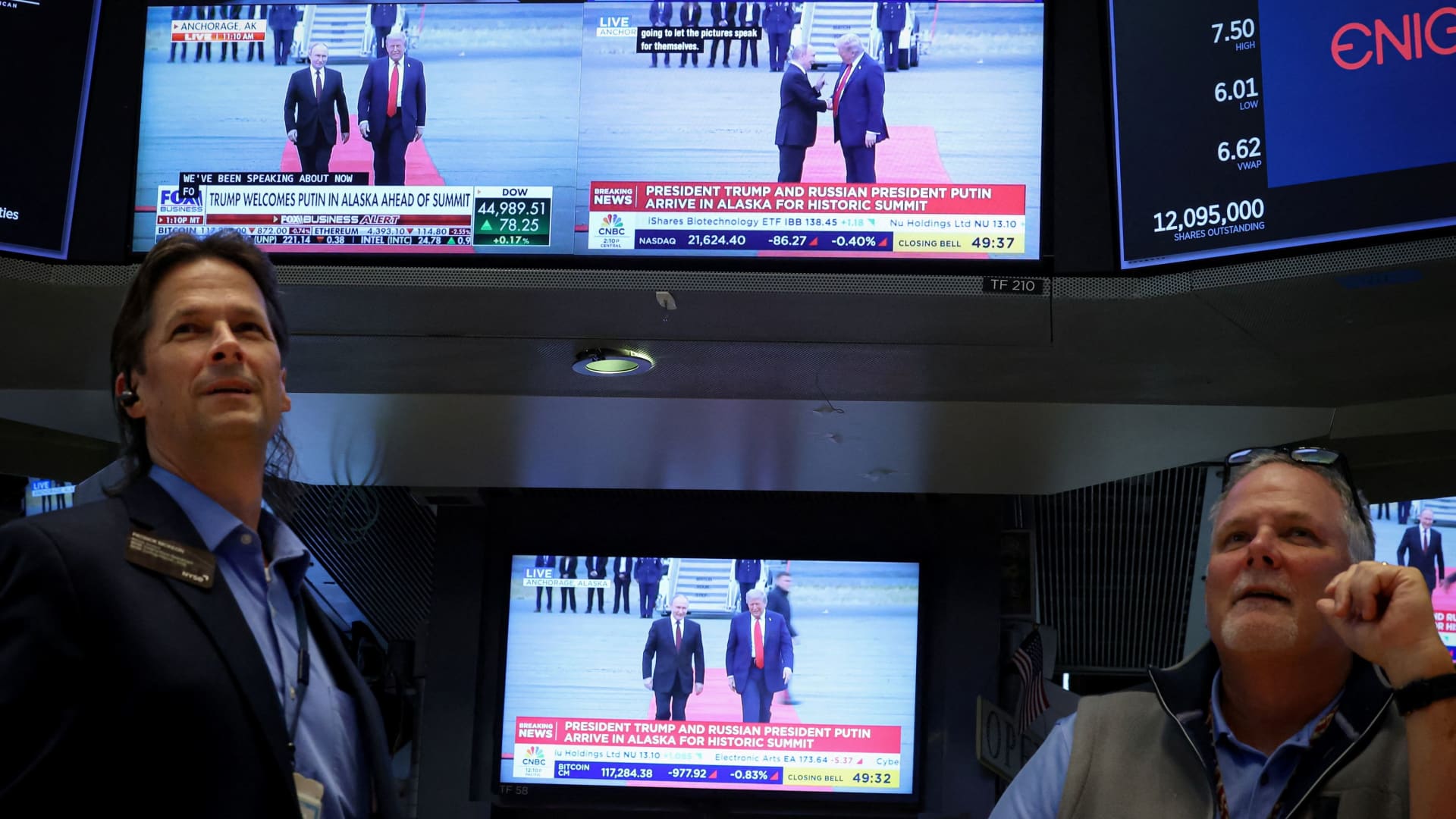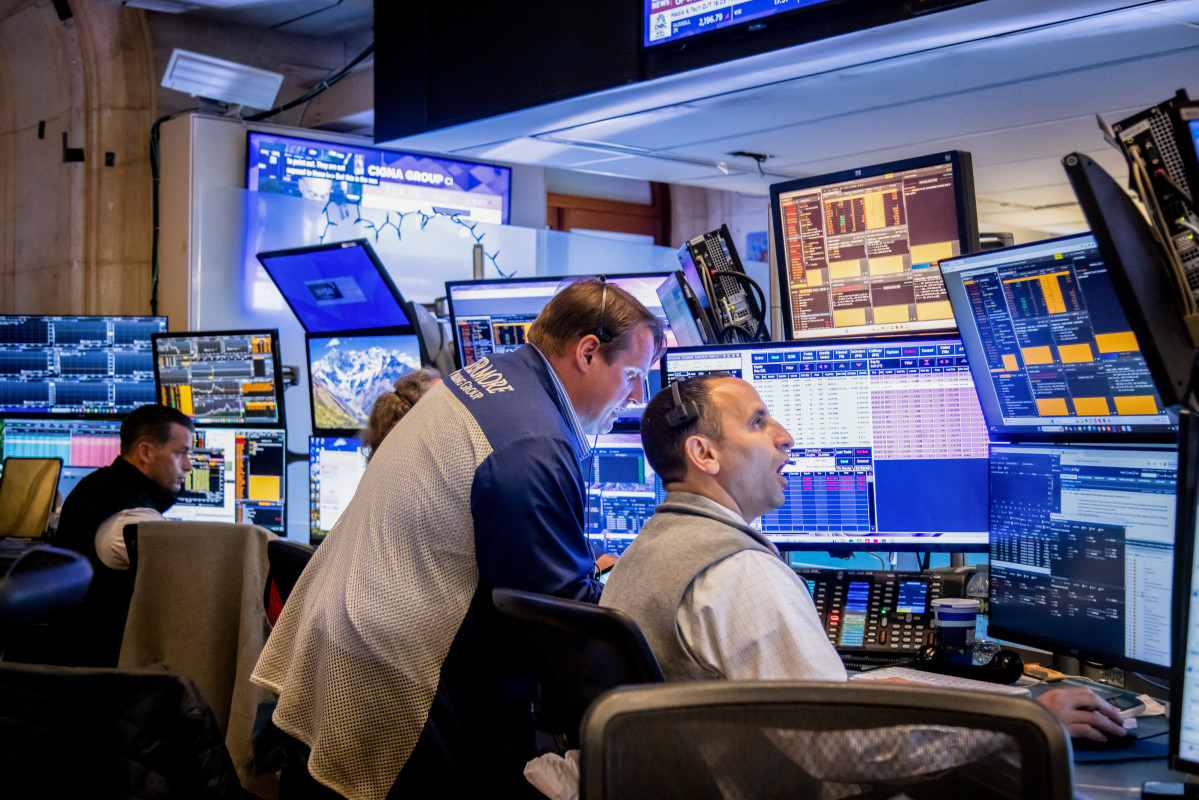Traders watch as U.S. President Donald Trump greets Russian President Vladimir Putin, as they meet to negotiate for an end to the war in Ukraine, at Joint Base Elmendorf-Richardson in Anchorage, Alaska, on the floor at the New York Stock Exchange in New York City, U.S., August 15, 2025.
Brendan McDermid | Reuters
This is CNBC’s Morning Squawk newsletter. Subscribe here to receive future editions in your inbox.
Here are five key things investors need to know to start the trading day:
1. October surprise
Stocks tumbled on Friday after President Donald Trump threatened a “massive increase of Tariffs” on Chinese goods. Trump’s comments came after Beijing expanded its export restrictions on rare earth materials — a move Trump described as “hostile” in a social media post.
Here’s what to know:
- The three major indexes all recorded their worst sessions in several months on Friday.
- The U.S. stock market relinquished $2 trillion in value following Trump’s Friday morning post, Bespoke Investment Group found.
- The sell-off ended what had been a calm period for the market. The CBOE Volatility Index, know as Wall Street’s “fear gauge,” jumped to levels not seen since June, while the S&P 500 snapped its 33-day streak without a move of at least 1% in either direction.
- After the market closed, Trump announced 100% levies on imports from China as well as export controls on critical software, beginning Nov. 1.
- A Chinese official over the weekend said the country is “not afraid” of a trade war.
- Stock futures surged this morning after Trump said on Sunday that the situation with China “will all be fine.” China President Xi Jinping “doesn’t want Depression for his country, and neither do I,” Trump wrote on Truth Social.
- Follow live markets updates here.
2. Interest initiative
Exterior view of JPMorgan Chase & Co. branch on January 14, 2025 in New York City, New York.
Kena Betancur | View Press | Corbis News | Getty Images
JPMorgan Chase announced this morning that it is officially launching its plan to take stakes in companies it views as core to U.S. interests and national security.
The bank said it will invest as much as $10 billion into companies across several categories, including defense and aerospace and energy technology. CNBC’s Hugh Son notes that the plan is part of JPMorgan’s broader Security and Resiliency Initiative, which will involve the bank financing or facilitating $1.5 trillion in funding for companies it sees as crucial to U.S. interests.
Shares of the bank popped 1.4% in premarket trading.
3. Pink slips or paystubs?
U.S. President Donald Trump looks on during an announcement about lowering U.S. drug prices, at the White House in Washington, D.C., U.S., Oct. 10, 2025.
Kent Nishimura | Reuters
The Trump administration said it began laying off federal workers on Friday, as the government shutdown nears its third week will no end in sight. Trump, who had previously warned that the shutdown would lead to permanent reductions in the federal workforce, said “a lot” of government employees would be cut.
Over the weekend, the president said his administration had “identified funds” to pay military members if the shutdown continues through Oct. 15 — when active duty members of the armed services are scheduled to receive their next paycheck.
Vice President JD Vance meanwhile took aim at the Affordable Care Act credits that have been the lightening-rod issue in Congress’ funding stalemate. Vance said Sunday that there is “a lot of waste and fraud” in the Obamacare subsidies, and that the White House wants to ensure that “the tax credits go to the people who need them.”
4. Cool kids
NEW YORK, NEW YORK – APRIL 13: General view of Macy’s store in Midtown Manhattan on April 13, 2025 in New York City.
Anthony Devlin | Getty Images
Gen Z may not be shopping at department stores, but baby boomers are. Just look at Macy’s and its subsidiary Bloomingdale’s, for example: Data shows a majority of their shoppers are older than 45.
Boomers may be pleased with in-store perks like lax return policies and promotional events, and loyalty from the generation could help buoy department stores amid the rise of online retailers.
But when it comes to winning over younger shoppers, department stores’ popularity among baby boomers may end up be what’s getting in their way. As one retail adviser put it, the mindset for younger consumers is: “I don’t want to shop where my mother shops.”
5. Building blocks
People depart a Lego store in Manhattan on August 29, 2024 in New York City.
Spencer Platt | Getty Images
More than 1 million children around the world have used Lego’s toy MRI scanner sets in preparation for their medical procedures, the toymaker announced today.
Research from the company shows 96% of healthcare professionals said the two-year-old model has helped reduce kids’ anxiety. Close to half said they have less of a need for sedation after children played with the miniature MRI set.
The Daily Dividend
Earnings season is kicking back into high gear. Here’s what we’re watching this week. (Some economic releases will not come out as scheduled should the government shutdown continue.)
CNBC Pro subscribers can see a full calendar and rundown for the week here.
— CNBC’s Laya Neelakandan, Ana Teresa Solá, Jessica Dickler, Lora Kolodny, Dan Mangan, John Melloy, Sean Conlon, Sarah Min and Kevin Breuninger contributed to this report. Josephine Rozzelle edited this edition.


